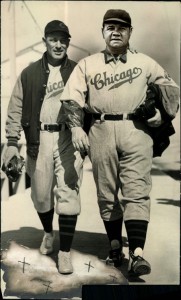On August 11, 1929, Babe Ruth sent a Willis Hudlin pitch over the right field wall for his 30th home run of the season. The Yankees lost that game 6-5 but “The Bambino” made history as the charter member of the legendary 500 home run club. Before Ruth, the concept of a 500 home run hitter seemed ludicrous as his predecessor to the throne, Roger Conner, held the top mark for 24 years with 138 dingers. Oh, you could make the argument that those were the “dead-ball” days and the game changed dramatically in the 1920’s (and of course, it did), but consider that the same day Ruth touched all four bases for the 500th time in his career, #2 on the list was 33-year old Rogers Hornsby, who also hit a home run and pushed his career total to 233. It takes a combination of consistent greatness and injury-free longevity to reach the magic number, with the long list of baseball players that came up just short including such icons as Lou Gehrig (493), Stan Musial (475) and Carl Yastrzemski (453).
Welcome to the Club! Ruth has Company
 As the home run became a more integral part of the game, players came along with greater power and longevity. Though challenging Ruth’s 714-lifetime homers was still a pipedream, the idea that another superstar could join Ruth at the 500 home run plateau seemed attainable given the right circumstances. When Babe set the single-season record in 1927 by notching 60 round-trippers, a mark that would stand for over 30 years, he single-handedly hit more home runs than every TEAM in the American League. Teammates Gehrig and Lazzeri finished 2nd and 3rd with 47 and 18 respectively. But just five years later, with Ruth’s career winding down, the 30 home-run hitter was no longer an aberration. Eleven years after Ruth started the club, Jimmie Foxx next crossed the barrier and New York’s Mel Ott joined as the first member from the National League five years after that. Where once there was just Ruth now stood three. But it was time to set a few more places at the table, this party was just getting started!
As the home run became a more integral part of the game, players came along with greater power and longevity. Though challenging Ruth’s 714-lifetime homers was still a pipedream, the idea that another superstar could join Ruth at the 500 home run plateau seemed attainable given the right circumstances. When Babe set the single-season record in 1927 by notching 60 round-trippers, a mark that would stand for over 30 years, he single-handedly hit more home runs than every TEAM in the American League. Teammates Gehrig and Lazzeri finished 2nd and 3rd with 47 and 18 respectively. But just five years later, with Ruth’s career winding down, the 30 home-run hitter was no longer an aberration. Eleven years after Ruth started the club, Jimmie Foxx next crossed the barrier and New York’s Mel Ott joined as the first member from the National League five years after that. Where once there was just Ruth now stood three. But it was time to set a few more places at the table, this party was just getting started!
The 1950’s – Going, Going …. Gone!
 It would be another 15 years before baseball would see another 500 homer guy with Ted Williams gaining admittance in 1960, having lost several years to military service. And while the 1950s didn’t celebrate a 500 home run hitter, it produced a new wave of superstars that made it the golden age of baseball and opened the club to new membership. Mickey Mantle and Willie Mays started their assault on “The Big Apple” in 1951, followed by Eddie Mathews in ‘52, Ernie Banks in ‘53, Harmon Killebrew and Hank Aaron in ‘54, Frank Robinson in ‘56 and Willie McCovey in ‘59. Eight new members that began their careers in the 1950s had all crossed into the club, with Mantle and Mathews doing it two months apart in 1967 and Aaron joining exactly a year after Mathews. Adding in Reggie Jackson, Mike Schmidt and Eddie Murray, the 500 home run club was up to 15 members, all of which are enshrined in the Baseball Hall of Fame. Since 1999, 12 more members have entered the 500 home run club since; McGwire,Palmeiro, Bonds, Sheffield, Sosa, Griffey, F. Thomas, Thome, M. Ramirez, A. Rodriguez, Ortiz and Pujols.
It would be another 15 years before baseball would see another 500 homer guy with Ted Williams gaining admittance in 1960, having lost several years to military service. And while the 1950s didn’t celebrate a 500 home run hitter, it produced a new wave of superstars that made it the golden age of baseball and opened the club to new membership. Mickey Mantle and Willie Mays started their assault on “The Big Apple” in 1951, followed by Eddie Mathews in ‘52, Ernie Banks in ‘53, Harmon Killebrew and Hank Aaron in ‘54, Frank Robinson in ‘56 and Willie McCovey in ‘59. Eight new members that began their careers in the 1950s had all crossed into the club, with Mantle and Mathews doing it two months apart in 1967 and Aaron joining exactly a year after Mathews. Adding in Reggie Jackson, Mike Schmidt and Eddie Murray, the 500 home run club was up to 15 members, all of which are enshrined in the Baseball Hall of Fame. Since 1999, 12 more members have entered the 500 home run club since; McGwire,Palmeiro, Bonds, Sheffield, Sosa, Griffey, F. Thomas, Thome, M. Ramirez, A. Rodriguez, Ortiz and Pujols.
MHCC Offering Collection of Game-Used Bats from Each Member of the 500 Home Run Club and More!
 The March MHCC auction will feature a game-used bat from each of the 27 members of the illustrious 500 home run club, highlighted by a 1921-31 Babe Ruth Louisville Slugger Professional Model MEARS A6 and PSA/DNA, 1926-27 Jimmie Foxx Spalding Rookie-Era PSA/DNA GU 9, 1939-40 Ted Williams Rookie-Era Louisville Slugger PSA/DNA GU 9, 1943 Mel Ott Louisville Slugger PSA/DNA GU 8, 1950-1960 Frank Robinson Rookie Era Signed Louisville Slugger PSA/DNA GU 8.5, 1950s Harmon Killebrew Louisville Slugger PSA/DNA GU 8.5, 1959-60 Eddie Mathews Adirondack PSA/DNA GU 10, 1960 Willie Mays Signed Louisville Slugger Used to Hit Career HR #278 PSA/DNA GU 9 and 1965-68 Mickey Mantle Louisville Slugger PSA/DNA GU. In addition, there are several other highly-prized wood gamers that include 1969-70 Pete Rose Game-Used and Signed Louisville Slugger Bat PSA/DNA GU 8, 1990s Mike Piazza Mizuno Pro Limited Game-Used Bat PSA/DNA GU 9.5, 1998 Tony Gwynn Game-Used and Signed Louisville Slugger Bat Used for Career Hit #2825 PSA/DNA GU 10, 2002 Derek Jeter Signed Louisville Slugger LOA/Steiner and PSA/DNA GU 9, 2007 Miguel Cabrera Game-Used Nokona Bat PSA/DNA GU 8.5 and 2013 Mike Trout Old Hickory Bat PSA/DNA GU 10. The auction runs from March 4th through to Thursday, March 21st.
The March MHCC auction will feature a game-used bat from each of the 27 members of the illustrious 500 home run club, highlighted by a 1921-31 Babe Ruth Louisville Slugger Professional Model MEARS A6 and PSA/DNA, 1926-27 Jimmie Foxx Spalding Rookie-Era PSA/DNA GU 9, 1939-40 Ted Williams Rookie-Era Louisville Slugger PSA/DNA GU 9, 1943 Mel Ott Louisville Slugger PSA/DNA GU 8, 1950-1960 Frank Robinson Rookie Era Signed Louisville Slugger PSA/DNA GU 8.5, 1950s Harmon Killebrew Louisville Slugger PSA/DNA GU 8.5, 1959-60 Eddie Mathews Adirondack PSA/DNA GU 10, 1960 Willie Mays Signed Louisville Slugger Used to Hit Career HR #278 PSA/DNA GU 9 and 1965-68 Mickey Mantle Louisville Slugger PSA/DNA GU. In addition, there are several other highly-prized wood gamers that include 1969-70 Pete Rose Game-Used and Signed Louisville Slugger Bat PSA/DNA GU 8, 1990s Mike Piazza Mizuno Pro Limited Game-Used Bat PSA/DNA GU 9.5, 1998 Tony Gwynn Game-Used and Signed Louisville Slugger Bat Used for Career Hit #2825 PSA/DNA GU 10, 2002 Derek Jeter Signed Louisville Slugger LOA/Steiner and PSA/DNA GU 9, 2007 Miguel Cabrera Game-Used Nokona Bat PSA/DNA GU 8.5 and 2013 Mike Trout Old Hickory Bat PSA/DNA GU 10. The auction runs from March 4th through to Thursday, March 21st.




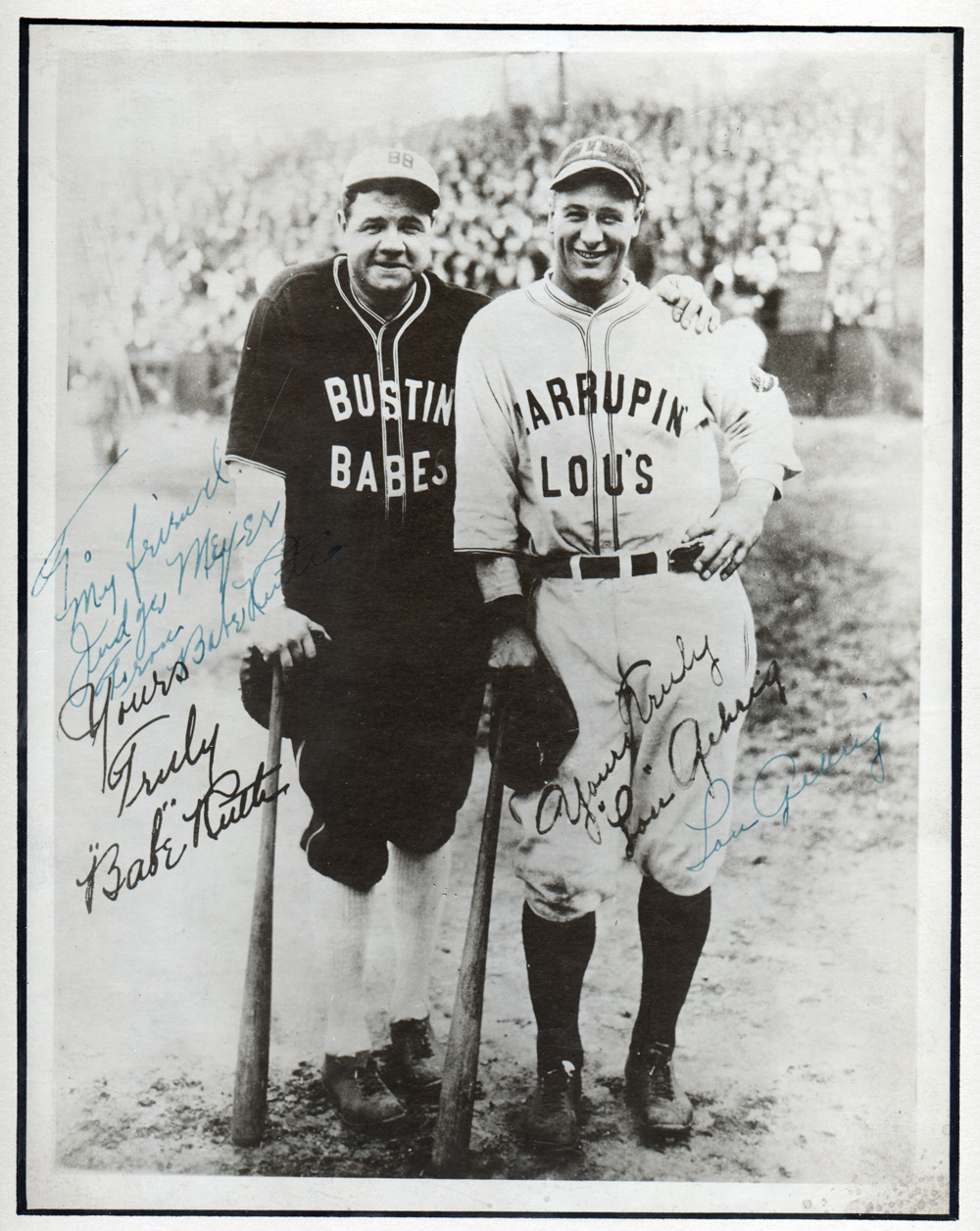 In an age when Giancarlo Stanton gets a 13-year, $325 million contract and Bryce Harper decides a 10-year agreement at $30 million per year isn’t enough, one has to wonder what teams would pay in today’s dollars to acquire the services of a Babe Ruth or Lou Gehrig. Would they be worth $40 million a year? Maybe $50 million? Long before the days of mega-sponsors and television revenues, baseball players (even the really good ones) didn’t make the kind of generational wealth that they do today. In fact, many took off-season jobs to supplement their income. In 1927, fresh off of a record-setting 60 home run season, Babe Ruth was paid an “audacious” sum of $70,000 per year, almost as much as the President of the United States at the time. But in today’s currency, that amounts to about a million dollars a year. Considering the league average in 2018 was just north of $4 million per year, the greatest player in baseball history at his peak was receiving the salary of a marginal major-leaguer in the present. That’s where “barnstorming” came in.
In an age when Giancarlo Stanton gets a 13-year, $325 million contract and Bryce Harper decides a 10-year agreement at $30 million per year isn’t enough, one has to wonder what teams would pay in today’s dollars to acquire the services of a Babe Ruth or Lou Gehrig. Would they be worth $40 million a year? Maybe $50 million? Long before the days of mega-sponsors and television revenues, baseball players (even the really good ones) didn’t make the kind of generational wealth that they do today. In fact, many took off-season jobs to supplement their income. In 1927, fresh off of a record-setting 60 home run season, Babe Ruth was paid an “audacious” sum of $70,000 per year, almost as much as the President of the United States at the time. But in today’s currency, that amounts to about a million dollars a year. Considering the league average in 2018 was just north of $4 million per year, the greatest player in baseball history at his peak was receiving the salary of a marginal major-leaguer in the present. That’s where “barnstorming” came in.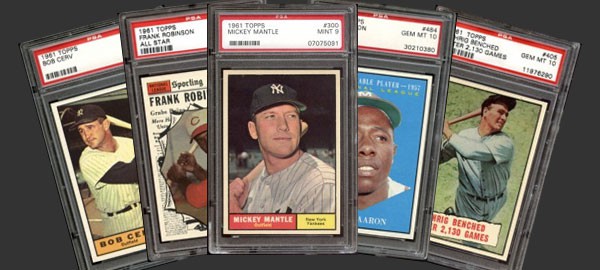
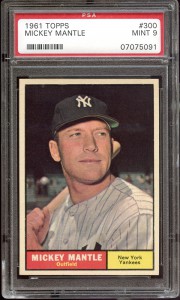 It was just 3 weeks into the start of a new year and America was inaugurating John F. Kennedy as its 35th President. World War II was long behind us but a new threat emerged from its aftermath, one that would leave our nation on edge for decades and change the culture of our society. In a time marked by unrest and uncertainty, the Topps Company released a 1961 baseball set that brought order to chaos.
It was just 3 weeks into the start of a new year and America was inaugurating John F. Kennedy as its 35th President. World War II was long behind us but a new threat emerged from its aftermath, one that would leave our nation on edge for decades and change the culture of our society. In a time marked by unrest and uncertainty, the Topps Company released a 1961 baseball set that brought order to chaos.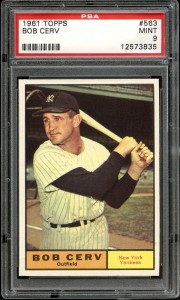
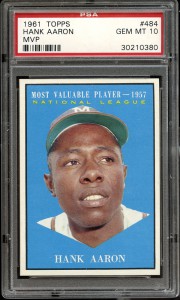
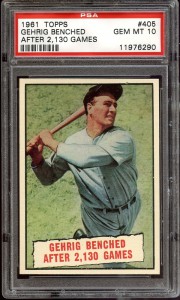
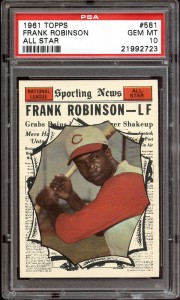
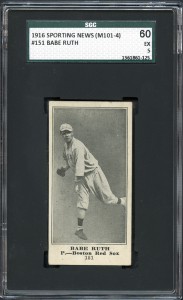 The most important rookie card ever produced!
The most important rookie card ever produced!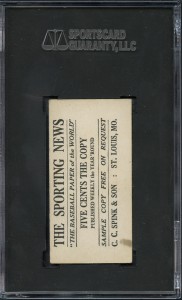 Offered is one of the most stunning, mid-grade M101-4 Sporting News Babe Ruth rookie cards in existence!
Offered is one of the most stunning, mid-grade M101-4 Sporting News Babe Ruth rookie cards in existence!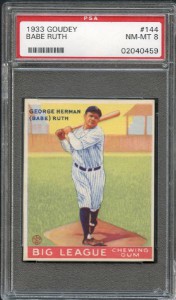
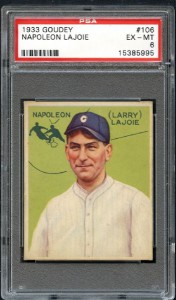 For an inaugural collection, the 1933 Goudey set initially appeared to have no “drama” other than a change to card #6 Jimmy Dykes, who was originally listed as 26 years old and later corrected to 36 years old. That is until collectors began to sense a common theme; they were all one card away from completing the set… and it was always the same card! While U.S. Caramel and George C. Miller had implemented a similar technique of short-printing one card so severely that only a few lucky patrons could complete the set, Goudey took the concept a step further by totally omitting card #106 completely, keeping customers buying their product in a futile search for the non-existent pasteboard. But it didn’t take long for Goudey’s subterfuge to be discovered and the missing card #106 was printed in the final run of the following year, explaining why it bears the design of Goudey’s 1934 product. It is unknown why Napoleon Lajoie, a star that had been retired for over 15 years, was made the subject of the missing pasteboard, but with the card produced in limited quantity and available only by mail to collectors that formally complained in writing, the “1933” Goudey #106 Lajoie ranks with the T206 Honus Wagner and the T206 Ty Cobb with “Ty Cobb” reverse as the most coveted rarities in sports card history.
For an inaugural collection, the 1933 Goudey set initially appeared to have no “drama” other than a change to card #6 Jimmy Dykes, who was originally listed as 26 years old and later corrected to 36 years old. That is until collectors began to sense a common theme; they were all one card away from completing the set… and it was always the same card! While U.S. Caramel and George C. Miller had implemented a similar technique of short-printing one card so severely that only a few lucky patrons could complete the set, Goudey took the concept a step further by totally omitting card #106 completely, keeping customers buying their product in a futile search for the non-existent pasteboard. But it didn’t take long for Goudey’s subterfuge to be discovered and the missing card #106 was printed in the final run of the following year, explaining why it bears the design of Goudey’s 1934 product. It is unknown why Napoleon Lajoie, a star that had been retired for over 15 years, was made the subject of the missing pasteboard, but with the card produced in limited quantity and available only by mail to collectors that formally complained in writing, the “1933” Goudey #106 Lajoie ranks with the T206 Honus Wagner and the T206 Ty Cobb with “Ty Cobb” reverse as the most coveted rarities in sports card history.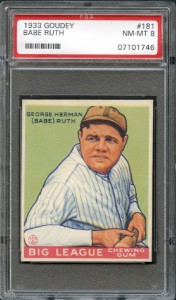
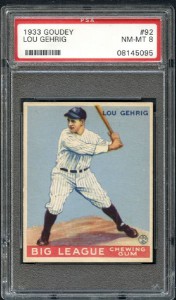
 I know what you’re thinking …. Are you crazy!?! What about 1927? A home run record that stood for 34 years until beaten by Roger Maris (*) and the most legendary team ever! All true, but keep in mind we’re focusing on the player, not the team, and the criteria is dominance, not records. True, in 1927 Ruth hit 60 home runs, more than any other TEAM in the American League. But Gehrig wasn’t far behind at 47, and in virtually every other category, Ruth’s numbers were not only better in 1921, they were far and away superior to the rest of the league. Second to Babe’s 59 homers in 1921 was a tie between Bob Meusel and Ken Williams with just 24. Babe’s 1921 season also included runaway crowns in On Base Percentage (.512 to .452 – Ty Cobb), Slugging Percentage (.846 to .606 – Harry Heilmann), Runs Scored (177 to 132 – Jack Tobin), Total Bases (457 to 365 – Heilmann), Runs Batted In (168 to 139 – Heilmann), and Bases on Balls (145 to 103 – Lu Blue). Ruth ranked #3 in the American League in Batting Average, #6 in Hits, #2 in Doubles, #4 in Triples, and even #8 in Stolen Bases. He even pitched in two games that season, winning both. And all before he had Lou Gehrig batting behind him in the lineup! His 1921 “Wins Over Replacement” of 12.6 also edges out his 1927 rating of 12.4, confirming that the 1921 season for “The Babe” was one of the greatest performances ever!
I know what you’re thinking …. Are you crazy!?! What about 1927? A home run record that stood for 34 years until beaten by Roger Maris (*) and the most legendary team ever! All true, but keep in mind we’re focusing on the player, not the team, and the criteria is dominance, not records. True, in 1927 Ruth hit 60 home runs, more than any other TEAM in the American League. But Gehrig wasn’t far behind at 47, and in virtually every other category, Ruth’s numbers were not only better in 1921, they were far and away superior to the rest of the league. Second to Babe’s 59 homers in 1921 was a tie between Bob Meusel and Ken Williams with just 24. Babe’s 1921 season also included runaway crowns in On Base Percentage (.512 to .452 – Ty Cobb), Slugging Percentage (.846 to .606 – Harry Heilmann), Runs Scored (177 to 132 – Jack Tobin), Total Bases (457 to 365 – Heilmann), Runs Batted In (168 to 139 – Heilmann), and Bases on Balls (145 to 103 – Lu Blue). Ruth ranked #3 in the American League in Batting Average, #6 in Hits, #2 in Doubles, #4 in Triples, and even #8 in Stolen Bases. He even pitched in two games that season, winning both. And all before he had Lou Gehrig batting behind him in the lineup! His 1921 “Wins Over Replacement” of 12.6 also edges out his 1927 rating of 12.4, confirming that the 1921 season for “The Babe” was one of the greatest performances ever! Known for his great passing ability in the latter stages of his career, Wilt Chamberlain’s early years were an all-out scoring assault on the NBA record book, obliterating career marks on an annual basis. His 1961-1962 statistics are ridiculous and read as a collection of virtually unmatchable accomplishments. Putting up over 50 points per game on an average of nearly 40 shots taken, Chamberlain bested second place scorer Walt Bellamy 50.4 to 31.6 and outrebounded Bill Russell 25.7 to 23.6 while playing virtually every minute of every game, including several double and triple overtime games. Chamberlain owns four of the top five point-scoring performances in NBA history, his 4,029 point ’61 season more than 400 points higher than the next best total, which was “The Big Dipper’s” 1962 season, and almost 1,000 points higher than the only other player in NBA history to eclipse the 3,000 point mark, Michael Jordan.
Known for his great passing ability in the latter stages of his career, Wilt Chamberlain’s early years were an all-out scoring assault on the NBA record book, obliterating career marks on an annual basis. His 1961-1962 statistics are ridiculous and read as a collection of virtually unmatchable accomplishments. Putting up over 50 points per game on an average of nearly 40 shots taken, Chamberlain bested second place scorer Walt Bellamy 50.4 to 31.6 and outrebounded Bill Russell 25.7 to 23.6 while playing virtually every minute of every game, including several double and triple overtime games. Chamberlain owns four of the top five point-scoring performances in NBA history, his 4,029 point ’61 season more than 400 points higher than the next best total, which was “The Big Dipper’s” 1962 season, and almost 1,000 points higher than the only other player in NBA history to eclipse the 3,000 point mark, Michael Jordan. Just like “Wilt the Stilt” in basketball, “The Great One” tallied unprecedented statistics on a yearly basis. While Wayne Gretzky owns the top five performances in NHL history and any of them could be touted for the top spot, his 1983-1984 season stands as the most dominant. Though not his personal best statistically due to missing six games, Gretzky distanced himself for titles in Goals (87 to 56 – Michel Goulet), Assists (118 to 86 – Paul Coffey) and Total Points (205 to 126 – Coffey) while leading the league in even strength goals, power play goals, shorthanded goals, plus/minus, and shooting percentage … but he was only second in the NHL in shots taken. Gretzky averaged an unbelievable 2.77 points per game, a full point per game over teammate Jari Kurri, in second place at 1.77 points per game, while leading Edmonton to its first of four Stanley Cup Championships in a five year span.
Just like “Wilt the Stilt” in basketball, “The Great One” tallied unprecedented statistics on a yearly basis. While Wayne Gretzky owns the top five performances in NHL history and any of them could be touted for the top spot, his 1983-1984 season stands as the most dominant. Though not his personal best statistically due to missing six games, Gretzky distanced himself for titles in Goals (87 to 56 – Michel Goulet), Assists (118 to 86 – Paul Coffey) and Total Points (205 to 126 – Coffey) while leading the league in even strength goals, power play goals, shorthanded goals, plus/minus, and shooting percentage … but he was only second in the NHL in shots taken. Gretzky averaged an unbelievable 2.77 points per game, a full point per game over teammate Jari Kurri, in second place at 1.77 points per game, while leading Edmonton to its first of four Stanley Cup Championships in a five year span.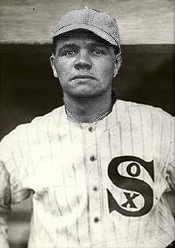 However, Frazee had another option; the Chicago White Sox offered star outfielder Joe Jackson and $60,000 cash for Ruth’s services; rejected in favor of the larger cash deal. Had the White Sox offer been successful, Joe Jackson would have patrolled the outfield in Boston and Babe Ruth would have played in Chicago. Well, for a short while anyway. With rumors of a conspiracy to fix the 1919 World Series continuing through the 1920 season, a grand jury was convened to investigate. While cleared of all legal charges, Jackson’s reign in the Boston outfield would have abruptly ended when Commissioner Landis issued a lifetime ban of Jackson and the other alleged co-conspirators. Ruth would have found himself toiling in relative obscurity, leader of an organization gutted by scandal that would finish no higher than 5th in the American League for the remainder of Ruth’s career. Instead of being the saving grace to restore baseball’s integrity, he would wear the cap of the team that destroyed it. There would be no “house that Ruth built” and no New York Yankees dynasty. “The Babe” likely would have been just another name among the greats, and the sport of baseball would have followed a very different path.
However, Frazee had another option; the Chicago White Sox offered star outfielder Joe Jackson and $60,000 cash for Ruth’s services; rejected in favor of the larger cash deal. Had the White Sox offer been successful, Joe Jackson would have patrolled the outfield in Boston and Babe Ruth would have played in Chicago. Well, for a short while anyway. With rumors of a conspiracy to fix the 1919 World Series continuing through the 1920 season, a grand jury was convened to investigate. While cleared of all legal charges, Jackson’s reign in the Boston outfield would have abruptly ended when Commissioner Landis issued a lifetime ban of Jackson and the other alleged co-conspirators. Ruth would have found himself toiling in relative obscurity, leader of an organization gutted by scandal that would finish no higher than 5th in the American League for the remainder of Ruth’s career. Instead of being the saving grace to restore baseball’s integrity, he would wear the cap of the team that destroyed it. There would be no “house that Ruth built” and no New York Yankees dynasty. “The Babe” likely would have been just another name among the greats, and the sport of baseball would have followed a very different path.